Company
Information
Service Areas
Contact Us
Showroom
Tauriko, Tauranga 3110
New Zealand
Not surprising that focusing on tasks is easier in a quiet room than in a loud one. If noise and interruptions are distracting you at work, your productivity will drop.
Companies are replacing open-space offices with flexible office arrangements. This allows people to choose how they want to work, which is becoming more popular. Open office layouts encourage teamwork but may decrease productivity over time, especially for introverted individuals.
A good solution in today’s modern office environment is to have designated quiet spaces. The reasons for having quieter areas to work in have been well-documented. Today’s flexible workspaces need quiet areas; creativity requires concentration and it's not just for the introverts amongst us.
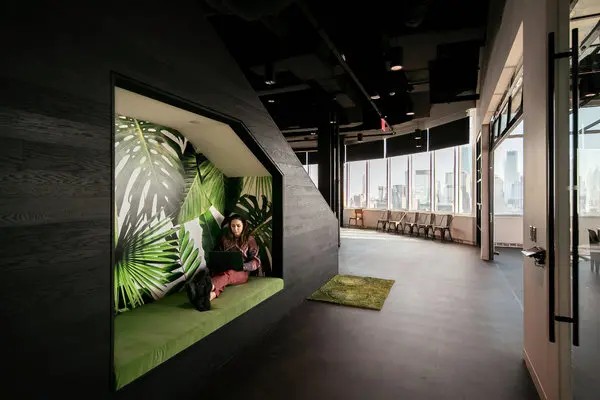
1. Being quiet promotes staying calm and composed. These, in turn, should result in faster work, higher work quality, and far less stress, which has a productive value of its own.
2. Quiet spaces give you time to reflect and analyse situations. Working in peace and quiet allows for clear thinking about the consequences of actions and the best way to move forward. This type of mindfulness at work is key to maintaining good relationships, reducing overwhelm and ultimately staying healthy.
3. Quiet zones, often separate areas, help prevent the spread of illness, especially important now.
4. Many people are now avoiding traditional boardrooms because they find them intimidating and formal. Staff have the option to not always use formal meeting rooms. They can choose to use more relaxed locations such as offsite venues or breakout spaces. Small offices can use hanging acoustic walls to create custom work and meeting areas, promoting a relaxed collaboration environment.
5. Open spaces in the office can improve collaboration, but privacy is also important for honest discussions with minimal distractions. Privacy pods are small meeting areas located strategically in a space. They offer a comfortable place for staff to discuss personal matters.
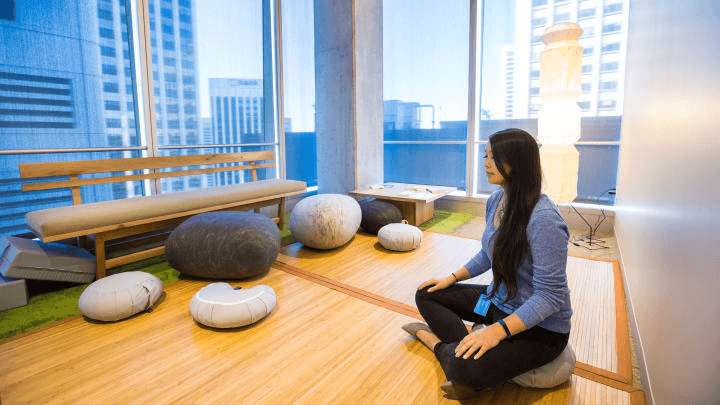
So what does the modern workspace that includes quiet spaces look like?
You can make special places for employees to relax or have alone time, like quiet spots or private rooms for mindfulness. This will help them focus better on their work tasks. This helps them concentrate on tasks.
To create quiet areas at work, think about the tasks, space, and team members in your office. Think about the type of work that requires a quiet environment. Evaluate the amount of space you can allocate for quiet zones. Consider the preferences and needs of your team members when creating these areas.
Talk to our team about putting in Soundbox booths or looking at other ways to make quiet and productive work areas. Our contractors can install Soundbox booths for you, or our team can recommend other ways to reach the same goal.
Open offices have gained popularity over the last decade, lauded for their potential to enhance collaboration, communication, and creativity among employees. However, the reality for many workers is quite different, as these open spaces often lead to distractions and heightened stress levels, ultimately resulting in decreased productivity.
Fortunately, there are alternative office layouts that can foster a more productive and peaceful work environment. Let's delve into some of the most effective alternatives to open office layouts and explore their benefits in more detail.
Offering employees the luxury of a private office can significantly enhance their ability to focus on tasks without being interrupted. These spaces also provide a quiet environment for phone calls and meetings, reducing anxiety and stress levels.
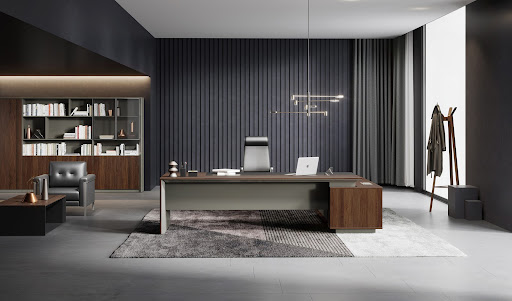
While traditional cubicles have a reputation for being uninspiring, modern cubicles are designed to offer a balance between privacy and collaboration. They can be customised to meet individual needs, such as adjustable height, lighting, and soundproofing, creating a more comfortable and productive workspace.
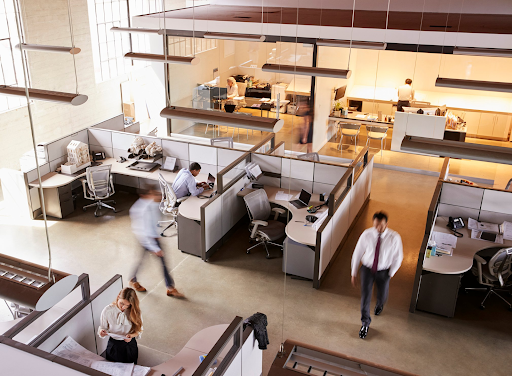
These workspaces divide the office into different zones, each tailored to specific tasks. This allows employees to choose a workspace that aligns with their working style, maximising the use of shared spaces and minimising distractions.
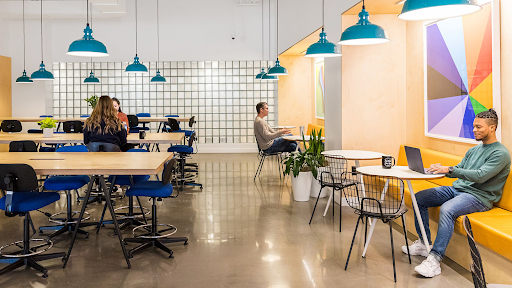
Satellite offices provide a private and focused workspace for employees who need it, without the hassle of commuting to a central office. This setup is particularly beneficial for project teams that need to move to different locations for various tasks.
This concept involves bringing entire offices into another office space, offering a balance between privacy and collaboration. OIOs provide access to shared amenities while allowing employees to work in a more private setting.
In conclusion, while open office layouts have their merits, they can also pose significant challenges to employee productivity, satisfaction, and well-being. The best alternative office layout depends on the specific needs and goals of your company. By considering and implementing one or more of these alternatives, you can create a more adaptable and dynamic workplace that supports your team's needs and promotes their success. Contact our experienced team today to discuss an office furniture plan that works for your staff.
Open-plan office spaces have become the go-to layout for many companies. They were designed to create a sense of collaboration and help break down barriers between departments. However, one major drawback is that these same open-plan office spaces are the noise factor and for those of us who work best with no interruptions and silence, these can be difficult to manage. Fortunately, some solutions can help reduce noise levels and make working in an open-plan office much more pleasant. Let’s explore how acoustic products can help manage noise levels in your workspace.
Acoustic products are designed to absorb sound energy, reducing reverberation time and creating a pleasant acoustic environment with reduced background noise levels. These products come in a variety of shapes and sizes, from wall panels to ceiling baffles, so they can be tailored to match the unique needs of your space. Some even double as decorative features to add a touch of personality to the room!

Not only will acoustic products reduce background noise levels in your workspace, but they will also improve speech intelligibility and audio clarity for meetings or conference calls. Having clear conversations ensures everyone is on the same page and helps ensure nothing is lost in translation due to excessive background noise.
With clever new products such as the Hush and Nectar Acoustic lights, you can not only have stylish lighting, but these clever products provide unparalleled acoustic comfort. With its unique honeycomb structure, made with lightweight acoustic fabric, the Nectar lightshade offers a softer, more direct light source to keep your office environment productive and vibrant. Nectar also comes in nine biophilic colours inspired by New Zealand’s natural environment.
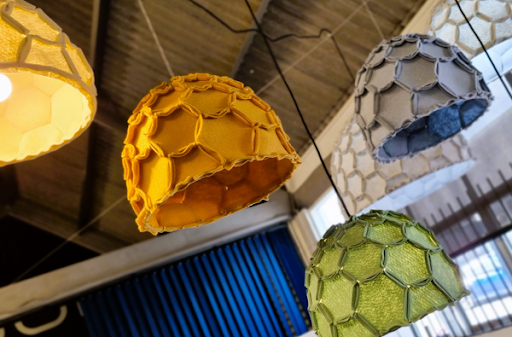
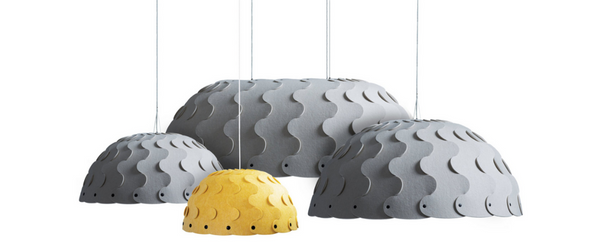
The Hush acoustic light is the perfect addition to your office or restaurant space; this innovative product was created in partnership with renowned designer David Trubridge Design Studio. Ideal for reducing distracting noise and improving the acoustics in a space, it is sure to create a calming and productive environment for all your tasks and meetings. As well as being an acoustic aid, this lighting wonder adds an elegant touch to any meeting table, task desk or restaurant bar.
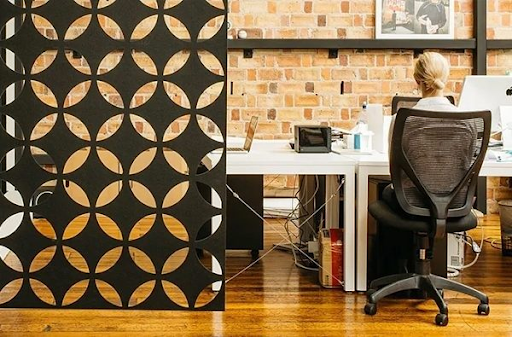
Cascade™ Hanging Screens are spatial and acoustic partitions that fall elegantly from the ceiling to the floor. Lightweight yet sturdy, Cascade™ Hanging Screens are semi-permanent by nature; easy to install, uninstall, and move around your space as required and can match your corporate identity easily.

Horizon™ is a range of floating acoustic panels that create a cloud-like illusion when suspended. With clean lines and simple, two-dimensional geometric forms, Horizon elegantly holds space as both a design feature and a high-performance acoustic absorber.
Soundbox silence booths are a versatile solution to offer quiet spaces within busy open-plan offices. They provide sound insulation for privacy and meetings, and also offer alternative workspaces for focused tasks, without the need for additional meeting rooms.
In addition to acoustic products, there are other measures you can take as well. For instance, adding area rugs or carpets not only softens footfall noise but also helps muffle sound waves from chair legs rolling across hard floor surfaces. You can also invest in sound masking systems which emit low-level white noise throughout the space to create a “noise blanket” effect that masks conversations without being intrusive or disruptive.
The right combination of acoustic products and sound masking systems can help reduce background noise levels considerably in any open plan office space - making it easier for employees to communicate clearly while still enjoying their collaborative environment. If you're looking for ways to reduce background noise without sacrificing style or comfort at your workplace, investing in acoustic materials is definitely worth considering.
Contact our team to discuss the options that would work best for your team!
As a business owner, there may come a time when you decide it's time to relocate your office. Whether it's to gain more space, be in a more convenient location for your employees and clients, or simply to upgrade your company's image, an office relocation is a major undertaking. In this blog post, we'll take a closer look at what an office relocation entails, including the planning process, the logistics of the move, and what you can do to make sure it goes as smoothly as possible.
Planning for an office relocation can take several months, and it's important to start the process as soon as possible so that you have enough time to properly prepare. Start by creating a detailed plan that outlines all the tasks that need to be completed before, during, and after the move. This should include things like packing up equipment and supplies, notifying clients and vendors, and arranging for transportation and logistics.
Once you have a plan in place, it's time to start getting everything ready for the move itself. This involves packing up all of your office equipment and supplies, which can take several days or even weeks depending on the size of your office and the amount of equipment you have. This is a great chance to declutter and remove old equipment and files that you no longer need. Make sure to label everything clearly so that it's easy to unpack and set up in your new space.
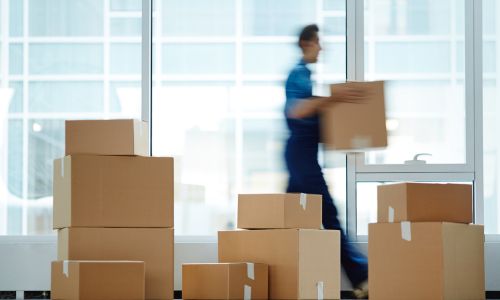
When it comes to the actual move itself, you'll need to arrange for transportation and logistics. This may involve hiring a moving company or renting a truck, depending on the size of your office and the amount of equipment you have. Make sure to get quotes from multiple companies before making a decision, and ask for referrals from other businesses who have gone through an office relocation to ensure that you're working with a reputable company.
Once you've moved everything to your new office, it's time to unpack and get settled in. Depending on the size of your office and the amount of equipment you have, this can take several days or even weeks. It's important to have a plan in place for setting up your new space, including things like where to put desks and other furniture, how to organize your files and supplies, and where to place equipment like computers and phones.
An office relocation is a major undertaking, but with the right planning and preparation, it can be a smooth, stress-free process. Start by creating a detailed plan that outlines all the tasks that need to be completed, and allow plenty of time for packing, transportation, and setting up your new space. Additionally, make sure to do your research and choose a reputable moving company to ensure that everything goes smoothly on the day of the move. With these tips in mind, your office relocation can be a success, and your business can continue to thrive in its new location.
If you’re refreshing your office space or moving to new premises and need a trusted and professional team to help with installing or relocating your commercial furniture, Modern Office can help.
The Modern Office team works with our third-party relocation service provider Mobel Installations to provide commercial furniture installations and office relocations.
Mobel Installations work with clients large and small and can get you up and running in no time. We work closely with the Mobel Installations team to develop a plan tailored to suit your project and business needs, with minimum disruption and maximum efficiency.
Our services include:
• Disassembly and removal of your existing furniture
• Transporting your furniture to a new location
• Installation of furniture into new premises
For a quote, call our friendly installation team on 0508 66 33 76 or email us.
And of course, if you need some new furniture as part of the moving process, view our range here.
Before embarking on any office fit-out, the question of budget is at the forefront of all our clients’ minds. After all, it's a significant factor in the decision-making process. Our simple answer to this question varies, as there are so many variables that can change the cost of your office fit-out.
Let’s start by looking at what is involved in an office fit-out and how the process works.
The term "fit-out" is used to describe the process of making an interior space suitable for occupants of an office, including all the necessary structures, electrical, furnishings, decorations, and mechanical equipment. In other words, the office space is fitted out with furnishings and decorations as well as equipment from mechanical and electrical services based on the needs of the occupant.
A full office fit-out from Modern Office focuses on the furniture and floor space around that furniture, and our process covers everything from initial design, right through to installation and after-sales support. We start by learning about the needs of your business and how your team works best. We discover whether they need breakout spaces, staff kitchen furniture, soft seating, visitor furniture, and much more.
Our floor planning service is an essential part of the overall process. An expertly designed floor layout is essential to designing a great working environment; this is achieved by translating your practical needs for the space into a specific furniture plan that reflects these requirements and then plan out the design of the space, which is brought to life with software. This visual plan includes our furniture recommendations, their colours, and styles so you can see if this matches your initial brief.
Once you are happy with the furniture, colours, and overall look of your future office space we deliver and install the office furniture and technology. It doesn’t end there, we provide ongoing after-sales support to ensure your workspace evolves alongside your business.
In terms of indicative costs for an employee, a basic soft fit-out including items such as an electric desk, screen divider, chair, mobile drawer, monitor arm, and soft wiring, could start at around $3,000.
To extend it further and include breakout spaces, a staff room, and small meeting rooms you’d be looking at around $5,000 per employee. These figures exclude custom storage, boardrooms, sound boxes, and receptions, which do tend to bump up costs but are valuable additions to enhance an office space.
All of this is dependent on whether you go for economical options or splurge on designer or custom-made items.
As office furniture specialists, we have an experienced team that has been lending a helping hand to clients since 2007. There’s no office too big, small, or niche for us to support with. We complete office fit-outs promptly after discussing a timeline with you. The amount of time it takes depends on the size of the office and the scale of the fit-out and the time it takes to source the furniture items you want.
Step one would be to contact us and tell us about your next commercial project. From there we can discuss what you are looking to achieve and the ways we can help. We’ll take care of everything else during the office fit-out, from design to delivery to installation.
Starting with the overall vision, we can narrow down options and give you a style that will suit your organisation’s culture, brand, and aesthetic. Our team are experts and even if you have a “high-level” idea of what you want, we can translate that into an achievable look. Visualising how your office space will look can be tricky, so we can talk you through the process and provide design advice that reflects your brand and brings out your organisation’s unique personality.
If this is the year that you want to level up your office space and create a fantastic culture that suits your entire team, book a consultation with us. We’ll be able to help you through all aspects of your office fit-out and create the perfect space your team will love!
A new office for the New Year? If you're thinking that it's time to make a change, contact our office fitout company. We can discuss what you would like to do to your existing office, or go through some ideas on how to fill a whole new space. Whatever you have in mind, we have the processes and experience to help. In the meantime, we thought we’d share four of the biggest office design trends for 2024 to give you the inspiration you're looking for!
With lockdown forcing many employees to work from home, office design experts are predicting that offices in 2024 will incorporate more homely touches. This could include the introduction of soft seating, plush carpeting and even something like our Soundbox acoustic booths where employees can enjoy their own space while completing certain tasks, such as participating in phone meetings. Anything that can be done to make a workspace feel more comfortable and welcoming is seen not just as a trend but also as a highly effective way to boost staff morale and productivity.
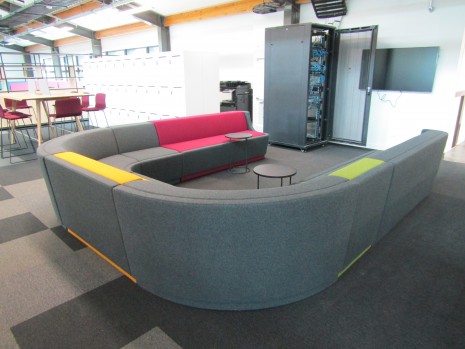
Another predicted trend for 2024 will be even more emphasis on natural elements indoors including materials and textures like wood and plants and, where possible, less artificial lighting to make way for a higher degree of natural light.
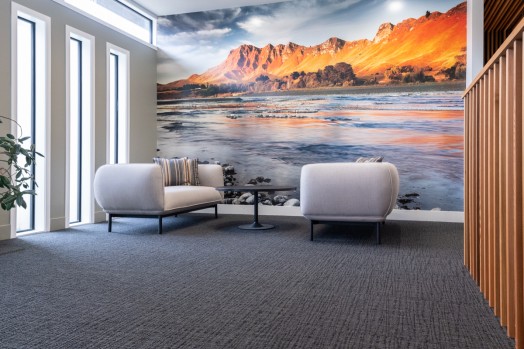
In other words, a less structured office fitout is expected to be a big hit in 2024. This might mean unassigned desks, more lounge-style seating areas where team members can work, and relaxed gathering spaces rather than the usual boardroom or corporate setting. This will give employees the freedom and flexibility to choose where they complete their work based on the assigned task, and how they meet up when required.
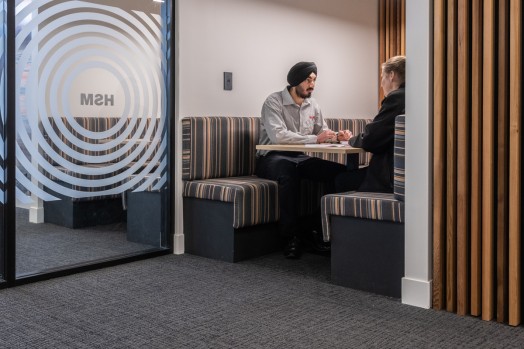
Office design professionals say the move away from grey and staid office settings will continue to gain momentum in 2024. This means we can expect to see brighter and more colourful spaces in the New Year. Dynamic design is seen as a highly effective way to boost energy as well as productivity.
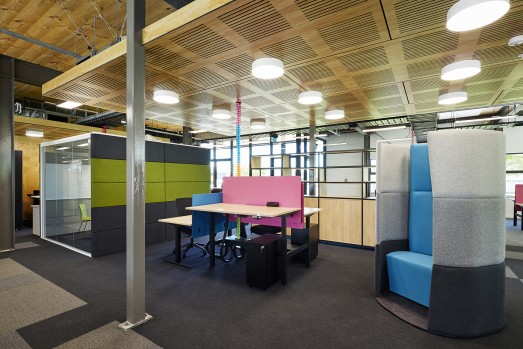
We hope we have given you something to ponder about your new-look office. We have the inspiration and products to help you achieve your ideal office space - and we’ll be happy to provide sound advice as well. Contact us and together we can create a spectacular new office for the New Year.
When it comes to designing a workspace, there are two distinct paths you can take — hard fitouts and soft fitouts. Modern Office has been providing creative workplace furniture solutions since 2007, and we understand what it takes to create functional, inspiring, and productive workspaces. In this blog post, we’ll explain the difference between hard and soft fitouts.
Hard fitouts involve all the construction work needed for an office space such as walls, floors, wiring, air-conditioning, and more. A hard fitout is the process of altering or refurbishing the base building that will play host to the designed space. It could be useful to think of it as the construction of the framework that an office space will inhabit, as it could include anything from re-flooring, to knocking out unnecessary or unwanted walls, to electrical work.
A hard fitout can involve changes to the physical structure of the office, such as partitioning walls, doorways, windows, or bathroom and kitchen facilities. Hard fitouts are usually required when moving into a new office or when making major changes to an existing one.
Generally speaking, these are more expensive than soft fitouts because they involve labour costs for builders and electricians as well as materials costs for things like plasterboard or tiles. They’re also longer in duration since they require more time for planning and execution.
Soft Fitouts, on the other hand, involve furnishing your workspace with items like chairs, desks, breakout furniture, and storage solutions. These are generally less expensive than hard fitouts since they don’t require any building work or labour costs. They also tend to be quicker in completion since there is no need for lengthy planning or construction timeframes. Modern Office are specialists in the soft fitout phase of a project. When you choose Modern Office for your workspace solution needs, you will receive personalised advice on furniture trends that will make sure that your commercial or office space is unique to your team’s needs while ensuring value is delivered every step of the way.
If your project involves both hard and soft fitouts, once the groundwork of the hard fitout is done, it’s time to focus on furnishings, and that’s where we come in. Having the ideal floor plan is a good and important start, which makes it easier to create a comfortable, stylish, and functional place for your team as a result. Filling your office space with furniture is an opportunity to express the character of your brand and reflect your business’ culture through aesthetics.
A high-quality soft fitout can make a substantial difference in the message a space sends and how inviting it can be. Just as a hard fitout covers more than just basic construction work, a soft fitout goes beyond office chairs and boardroom tables — depending on your needs, it could include breakout area couches, reception area furniture, artwork, and more.
So, which type of fitout is right for your business when you’re ready to make some changes? Choosing between a hard or soft fitout depends on numerous factors including budget constraints and timelines but also individual preferences. Understanding what each type entails allows business owners to make an informed decision when creating their perfect workspace solution — one that is both functional and inspiring at the same time!
If you're simply redecorating or making minor changes to your existing office space to refresh it or make it more functional for today’s employees' needs, then a soft fitout will probably suffice. However, if you're moving into a new office or making major changes to your current one, then a hard fitout will be necessary. Either way, Modern Office can help make your office design dreams a reality.
At Modern Office, we understand this process better than anyone else; having been providing creative workplace furniture solutions since 2007, we have developed a great reputation in delivering fitouts across both private and government sectors. Get in touch with us today if you would like some advice on how to create a unique workspace experience tailored specifically to your team’s needs!
As a business owner, facilities manager, or employee, you may have experienced various problems with your office. These problems can range from discomfort to low productivity to safety issues. However, did you know that office furniture can play a significant role in mitigating most of these problems? In this blog post, we'll cover the top 5 common problems you might face in your office and how office furniture can fix them.
One of the most common problems employees face is discomfort, which can lead to back pain and other issues. Uncomfortable chairs, desks that are too high or too low can cause problems for employees who are spending most of their day sitting. Investing in ergonomic furniture such as sit-stand desks, adjustable chairs, and proper lighting can help promote better posture, and reduce discomfort and back pain.

Another common issue with offices is noise pollution, which can be distracting and reduce productivity among employees. Excessive noise can come from nearby constructions, passing cars, co-workers talking, and equipment. Acoustic solutions like sound-absorbing panels, carpets, and acoustic partitions can help reduce noise levels. A quiet and peaceful office environment is crucial for employees' concentration, productivity, and overall well-being.
Open offices are the norm these days, but it can negatively affect employees’ privacy. Lack of privacy may lead to employees' inability to concentrate, reduced productivity, and potential conflicts. Thus, providing private and semi-open workstations with partition screens or panels can prevent distractions while allowing for privacy and collaboration between individuals or teams.

Cluttered offices can create a negative atmosphere, hamper productivity, and lead to accidents or injuries. Poor storage solutions, such as a lack of cabinets or stacking boxes, can contribute to this problem. Adequate storage options such as cabinets, bookshelves, and shelving units can help keep the office organised and make it easier for employees to find everything they need.
Too much equipment and furniture can take up office space, making it cramped and crowded. This lack of space can lead to safety concerns, communication issues, and reduced productivity. Choosing the right size of furniture, including desks and cabinets, and adopting an open-space concept can help optimise space in the office. It can also create a more welcoming, comfortable, and spacious office environment.

Now that you know the most common problems that occur in office environments and how office furniture can solve them, it's time to start making changes. Investing in ergonomic and comfortable office furniture, including storage units and acoustic solutions, can go a long way toward improving employee productivity, privacy, comfort, and overall well-being. Remember that a well-designed office space can reduce employee dissatisfaction and maintain a healthy and happy work environment. Speak to us about improving your workspace today!
A supportive desk chair helps with efficiency and productivity at work, as well as comfort and physical health. A problematic office chair - which could mean a good chair for the wrong person - could lead to aches and pains, repetitive strain injury, headaches and more. Whether you’re fitting out an office for fifty or setting up a home-based office for one, with so many options out there, it can be overwhelming when it comes time to choose. So we've put together this guide so you know what to look for when making your decision. The right ergonomic chairs will offer the following features:
Height adjustment, arm width and seat angle are just some of the adjustment options that a good office chair will offer. Our sit stand desks all come in different heights, shapes and sizes, so a chair that tailors to your unique needs is crucial. Office chairs should be easy to adjust in height. Feet should be flat on the floor (or a footrest) with thighs parallel to the ground. An adjustable seat depth/seat slide function allows you to slide the seat forward and backwards to suit your leg length. Armrests should be adjustable so they can provide additional support while working or resting. Adjustable armrests allow you to get closer to work, provide correct arm height and can also pivot.
A good office chair needs to support your lower back. Lower back pain, leg pain and sciatica are all common complaints among office workers, so it’s in your best interest to support yourself or your staff with a supportive chair. Having proper support can make a world of difference to your comfort levels. Your lower back should fit comfortably against the lumbar support.
Having the ability to recline limits the pressure placed on your spine and seat bones. Reclining while you work or rest improves comfort during long periods of sitting.
Make sure your office chair is on appropriate wheels (there are different requirements for carpet than for hard surfaces or mats) and moves around and swivels easily. You want your movements to be free, easy and unimpeded to get the most out of your time at your desk.
Choose a quality office chair that is made out of comfortable and breathable material. You’ll likely be sitting in this chair for eight hours a day, so you need comfort over style. Look for chairs with breathable material and quality seat cushioning for ultimate comfort. Choosing a chair with visual appeal can certainly add enjoyment to your office set-up, however comfort is crucial so make sure your chosen chair will ensure you are comfortable as you work, and will help to prevent pain and discomfort. We have a wide range of ergonomic task chairs available to suit different requirements. View our ergonomic chair collection here or contact us if you would like more information.
Here are 7 exercises you can do while sitting at your desk, allowing you to do a workout without leaving the office!
Raise your legs up on the very tips of your toes while remaining seated. Your calf muscles should start to burn after a few seconds. Hold for ten seconds and then repeat eight times.
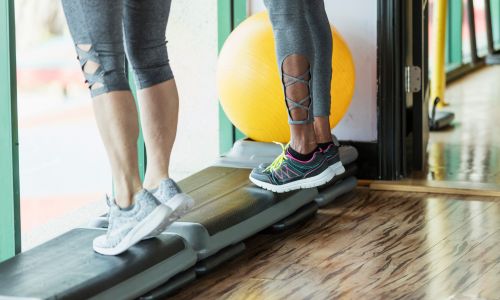
Typically done on the floor, you can also perform planks at your desk. Place your hands on the edge of your desk, walk your feet backwards and position them hip width apart. Your body should form a straight line from shoulders to heels. Try holding this position for up to one minute.

Clench your buttocks and hold for ten seconds. Do five sets of eight reps. The beauty of this exercise is that you aren't getting up and no one knows that you are secretly fitting in a workout.
Many arm exercises can be performed while seated at your desk. Stretch the muscles in your right arm by reaching as far to the left as you can with your right arm, while supporting it in the crook of your left elbow and then hold it there. Feel the stretch for five seconds. Do eight reps before switching over to your left arm.

Strengthen your core by rotating at the waist while remaining seated. Rotate as far to the left as you can and hold for five seconds, then repeat on the right. Complete five sets. Grab the backrest of your chair with your hands for support.
Move to the edge of your seat and lean back on the backrest. Straighten your legs and lift a few centimeters off the ground and raise your back a few centimeters off the backrest. Hold for ten seconds, you should feel a burn in your abdominal muscles. Do eight reps of 10 seconds.
Stand with your back against the wall with your feet shoulder-width apart and about two feet in front of you. Bending your knees, slide your back down the wall and hold this position.
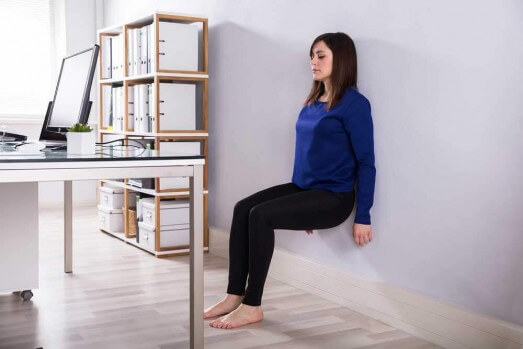
Being busy is no excuse to not exercise and stay healthy. Even if you don't have the time to exercise before or after work, there are many other ways you can incorporate movement into your daily routine. Doing regular desk exercises each day, along with getting up and walking around the office, can greatly improve health, muscle tone and strength.
With the new year upon us, now is the time to start thinking about how we can make your office more modern and contemporary in the ever-changing world of work. The future of office design is here, and we have compiled a list of five ideas to help you create an up-to-date space that will leave a lasting impression on clients and employees alike.
As technology continues to evolve at lightning speed, leveraging this in your office design is essential. This means everything from basics such as investing in high-speed internet connections and ergonomic furniture to incorporating automation into your everyday tasks. Not only will this make your office look modern, but it will also provide a boost in productivity and efficiency. More than ever before, technology is playing an integral role in how we work—from remote working capabilities to online tools that make it easier to share documents or collaborate with colleagues from other parts of the world.
When planning your office design for 2023, consider incorporating tech-friendly spaces such as dedicated charging stations where employees can charge their devices or breakout areas with built-in projectors where employees can easily connect their laptops or tablets with ease. Having these tech-friendly spaces available will make it easier for your team to stay connected no matter their location and keep your organisation on the cutting edge.
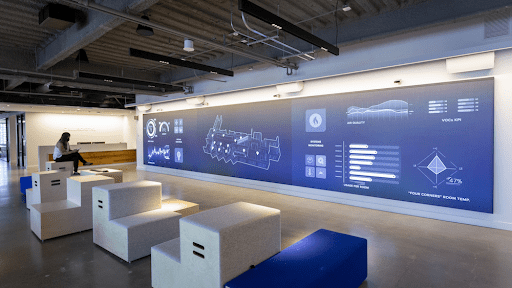
Open spaces are becoming increasingly popular as they provide more opportunities for collaboration and create an environment that encourages creativity. Consider adding low partitions or glass walls instead of solid walls to create an open feel without sacrificing privacy or soundproofing. Additionally, be sure to incorporate plenty of comfortable seating options into the design so that employees can work together easily in their shared space. Open floor plans also provide natural light which helps create a more comfortable working environment and enhances morale among staff members. If your current office setup doesn't have enough natural light, consider adding some light fixtures or big windows to bring in more brightness throughout the day.
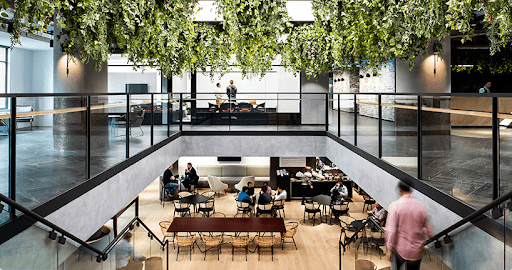
Incorporating natural elements into your office design has been linked with improved productivity and mental well-being among employees. Adding plants or using natural materials such as wood or stone can help brighten up the space while providing a calming atmosphere. Additionally, consider installing skylights or windows to let in more natural light – studies have shown that natural lighting can reduce stress levels and increase productivity. Biophilic design elements such as plants, water features, or living walls can help create a calming atmosphere in any workspace while providing numerous physiological benefits such as improved concentration and creativity. Biophilic design elements can also help reduce stress levels among employees by connecting them with nature while they're indoors. Incorporating these elements into your office design can have a positive effect on both productivity and mental well-being at work.

Colour plays an important role in setting the tone of a space, so carefully consider which colour palette best suits your brand’s identity before making any decisions about paint colours or furniture fabrics. Colours have been proven to affect emotions and behaviour, so it’s important to choose the right shades to encourage productivity rather than distract from it! For example, blue hues are thought to promote focus while green evokes feelings of relaxation and calmness.
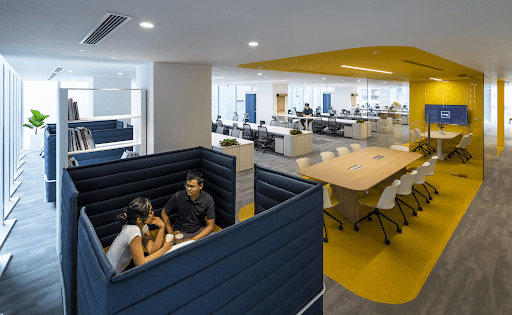
Finally, don’t forget about personalisation when designing your office space! Adding personal touches such as framed artwork or photos can help create a sense of belonging among employees while simultaneously giving visitors a warm welcome as soon as they enter the room. Don’t be afraid to get creative – this could mean anything from hanging wall art featuring local artists or installing bean bags for impromptu meetings. The line between home and work is very blurred now and workers want to feel at home within their workspace; this helps make them feel relaxed and is bound to bring out the best in them.
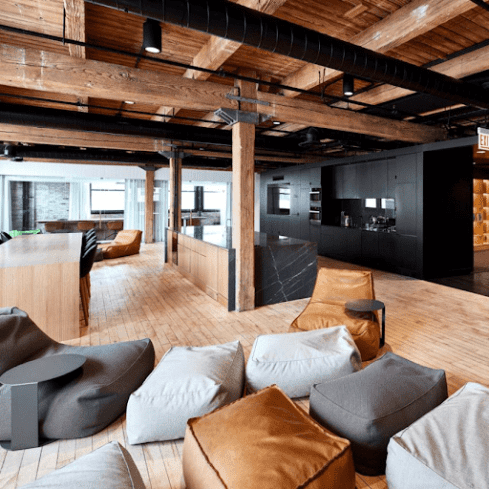
So there you have it. 2023 is the year that you can be well on your way to creating a modern workspace that will not only impress clients but also keep employees engaged and productive. Investing time into updating your office design now will pay off dividends down the line; start planning today! If you need some inspiration, head to modernoffice.co.nz or contact us today, we’d love to chat!
Many organisations are adopting hybrid working now, but what does it actually mean?
According to the Cambridge Dictionary, hybrid working is “a way of working that combines time spent in an office with time spent working from home, typically using technology such as the internet and email to stay in touch with colleagues.” In other words, it’s a mix of traditional office work and remote work which is more the norm these days.
During the pandemic, many organisations adopted hybrid work models out of necessity. However, there are many benefits to hybrid working that make it worth considering as a long-term solution for your business if it isn’t already. For example, hybrid working can lead to increased productivity, improved work/life balance for employees, and reduced overhead costs for businesses. To do it successfully and support staff members, understand expectations on both sides so there’s no ambiguity, keep a focus on well-being and create an office environment that supports productive work when employees are in the office.

Here are some ways that hybrid working can be supported with your office furniture choices:
When employees are splitting their time between the office and home, it’s important to consider ergonomics. After all, they’ll need to be comfortable whether they’re sitting at a desk or working at a kitchen table. Look for furniture that is adjustable so that employees can find the perfect position for their bodies regardless of where they’re working. For example, adjustable-height desks are a great option because they can be used as both sit-down desks and standing desks.
If you’ve ever worked from home, you know that one of the challenges is finding a place for all your stuff. When you’re only in the office part-time, you can’t just leave everything out on your desk—you need to be able to pack it up and take it with you when you head home for the day. That’s why it’s important to get creative with storage solutions when furnishing a hybrid workplace. For example, you could get mobile storage cabinets that fit under your desk so that you can easily access your files whether you’re in the office or at home. Or if you don’t need physical files, consider getting each employee a laptop safe or locker where they can store their laptop and belongings when they’re not in use.

Another important consideration when furnishing a hybrid workplace is seating. Keep in mind that not everyone will want to sit at a desk all day—some people may prefer to work from couches or chairs instead. So make sure there is plenty of varied seating in your office so that everyone can find a spot that suits their needs. And if possible, try to get furniture that is portable so that employees can move it around as needed throughout the day. For example, beanbag chairs or ottomans are a great option because they can be easily moved and reconfigured as needed. Or if people don’t want to sit at all, consider height-adjustable desks which are small enough to fit in home offices.

Soundbox silence booths are a versatile solution to offer quiet spaces within busy open-plan offices. They provide sound insulation for privacy and meetings, and also offer alternative workspaces for focused tasks, without the need for additional meeting rooms.
Another option is acoustic screens, which are spatial and acoustic partitions that fall elegantly from the ceiling to the floor. Lightweight yet sturdy, acoustic screens are semi-permanent by nature; easy to install, uninstall, and move around your space as require plus add colour that can perfectly harmonise with your brand.

The benefits of hybrid working are numerous—for both employees and employers alike—which is why more and more organisations are considering implementing this type of work model moving forward. If you're thinking of doing so in your own organisation, there are some things you'll need to take into account—namely how you're going to furnish your office space to support this type of work model.
By considering ergonomics, getting creative with storage solutions, and ensuring there's enough seating (just to name a few), you can set your team up for success in their new hybrid workplace! Ask the team at Modern Office how to get started in your organisation today.
The term biophilic is becoming a lot more popular when describing workspaces these days, and there are a number of reasons that this design movement is gaining momentum.
But what exactly is it and why should the modern workplace consider biophilic elements in their design? Biophilic design is defined as a concept used within the building industry to increase occupant connectivity to the natural environment through the use of direct nature, indirect nature, and space and place conditions. As more people return to the workplace, we are seeing how significant biophilic elements can be. Employers are keen to explore and upgrade the office environment for their people so they are just as comfortable at work as they have been at home. This is bringing forth a new norm and creating a post-pandemic standard that integrates biophilia amongst other things, within the workplace.
But biophilia is more than just an aesthetic philosophy—biophilic design has been found to support cognitive function, physical health, and psychological well-being. The concept of incorporating biophilic design into offices is to encourage the connection between humans and nature, as well as promote staff wellness and productivity.
Today more so than ever, employees need places and spaces to connect, engage, and identify with. To embrace biophilic design, we need to reimagine how we engage with and operate in the workplace, promote learning and collaboration, while placing employee health and wellness at the forefront of the design.
Implementing biophilic design doesn’t have to be a major undertaking. Guided by social ecologist Stephen Kellert’s 6 principles, any organisation could start by making minimal changes to a space, which on its own could impact the environment and users positively.
These biophilic design principles include:
• Environmental features
• Light and space
• Natural shapes and forms
• Natural patterns and processes
• Place-based relationships
• Evolved human-nature relationships
A good place to start incorporating biophilia in the workplace is to embrace the first three principles. Adding greenery, making better use of daylight, utilising natural ventilation, and adding water features within a space can help bring some of nature’s key elements into the office.
The Modern Office team recently attended Worktech, and one of the inspiring examples of biophilia in the workplace was from law firm Meredith Connell, who created a life-sized terrarium for their Auckland office.

A large portion of MC’s staff are Generation Z, so creating an environment that appealed to this age group was a key driver in their decision making. They maximised the social aspects of workspaces by creating a lunchroom/staff area for their team to socialise and collaborate in, with soft seating to relax in.
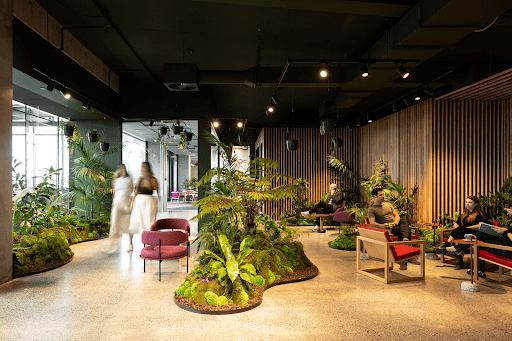
If you’re considering refreshing your environment, here are our tips on simple ways to incorporate biophilic elements into your workplace:
• Expose yourself to plants indoors. These planters and plant walls can quickly add greenery to corporate spaces.
• Let natural light in wherever possible, or get outside and experience it during the day.
• Listen to nature sounds.
• Use natural shapes and forms in your furniture choices. Our Mello sofa or chair options like Ava introduce softness and curves to spaces that traditionally have harsh straight lines.
• Bring people together. Create a space within your office that encourages human contact and collaboration. Employees crave this especially after the pandemic, and they want spaces that are reminiscent of their homes where friends congregate.
If you would like some advice on refreshing your workspace for renewed energy this spring, get in touch with our team today.
As a professional, you want to ensure maximum productivity in your workspace, but have you ever considered the impact of your office's organisation on your or your team’s productivity? Workplace organisation encompasses much more than just the physical arrangement of desks and chairs; it refers to streamlining processes, resources, and tasks in a way that reduces clutter, promotes optimal workflow, and ultimately boosts productivity. In this blog, we'll explore the critical role of organised office spaces in enhancing productivity in your business.
A cluttered workspace, with piles of papers and multiple tasks competing for our attention, can be overwhelming and sap our mental energy. By adopting an organised approach to your workspace, you streamline your work processes, freeing up your mental space, which translates to increased productivity. Additionally, an organised office environment helps reduce distractions and allows employees to focus their attention on the task at hand.
An organized workplace promotes a systematic approach to work processes, making it easier to identify and eliminate inefficiencies. By decluttering, prioritising tasks and processes, and streamlining workflows, time-consuming or redundant processes are eliminated, resulting in lower operational costs and improved productivity.
A cluttered workspace poses an unnecessary risk to your employees' health and safety. An organised office environment is vital to minimise the incidence of work-related injuries such as trips or falls, as well as other health hazards such as exposure to dust or chemicals. Implementing an organised office space also minimises stress levels, which can lead to improved overall health in the workplace.
An organised workspace not only makes it easier for employees to work, but it also improves the professional image of your business. An cluttered and unorganised workspace can leave visitors with a negative impression of your organisation. An organised workspace, on the other hand, presents an environment that portrays professionalism and a commitment to quality.
A clean and organised workspace can boost employees' morale and job satisfaction levels. When employees have a sense of order and control over their workspace, they are more motivated to work productively. Additionally, an organised workspace encourages a positive team culture where employees can thrive and excel in their roles.
So now that you know the benefits, how do you go about keeping your space more organised?
Effective storage is the obvious way to keep clutter out of sight. Here at Modern Office, we’ve got a range of storage options from mobiles to tambours to cupboards, in any look that your office needs. If your organisation embraces hot-desking, then consider lockers for safekeeping your team’s items as well.
Our range of desk partitions are also a way to minimise mess and keep your work area looking tidy and professional. Additionally, if you have an open plan space and need some separation, then our Cascade panels offer a colourful acoustic solution to keep areas defined and give your space a more organised feel.
An organised office space is about much more than just keeping your desk tidy. It's about creating an environment that promotes a streamlined workflow, improved efficiency, and ultimately enhanced productivity. By adopting an organised approach to your workspace, you can create a positive work culture that boosts employee morale and job satisfaction levels, resulting in increased productivity and success for your business. Modern Office can source a large range of items that can help get your workspace to work better for you and your team. Our experience in fitting out larger workspaces means that we can find a bespoke solution and design advice for your unique workspace regardless of size and budget. Get in touch with our team today!
To celebrate our 15th birthday *pause for applause*, we’ve put together 15 epic ways to refresh your workspace whether you’ve been in your office one year or several. It’s important to keep things fresh in an office environment in order to keep your employees happy and productive. Change is good and, when done with Modern Office, change can make a difference. Here’s our list:
This area is the first place that makes an impression when people enter your business. Creating a warm and stylish atmosphere here can help make visitors feel relaxed.
#1 Lunar Table: To prevent the reception desk from becoming cluttered, add a small guest table to place informative documents, leaflets, and the ever-important covid sign-in and QR codes.
#2 Jubel Chair: This stylish and comfortable chair is inviting for company guests to take a seat and means they won’t mind if your previous meeting runs over by a minute or two.
Bring your team together in a meeting room that encourages collaboration and teamwork.
#3 Harmony Chairs: This swivel chair makes movement easy and creates a flowy state that can benefit group thinking and collaboration.
#4 Meeting Table: Our Maxim Meeting Tables offer a large collective workspace for teams of up to a dozen people to join together to work on.
Work isn’t all about collaboration. Sometimes you have to focus on your own.
#5 Soundbox Booth: These acoustic booths are perfect for taking calls in a busy office or simply having a portion of quiet time for maximum productivity throughout the day.
To improve employee well-being and keep them all healthy, add ergonomic furniture to your office.
#6 Wobble Board: These keep your mind and body engaged throughout the day at your standing desk. Help subtly workout your core throughout the day, reduce fatigue and prevent back pain.
#7 Monitor Arms: Your monitor should be fixed at eye height to prevent neck pain. Place your monitor correctly with monitor arms for your double screen display.
These should be comfortable areas for spontaneous meetings.
#8 Oslo Bar Leaner: A perfect table for a breakout space. Grab a colleague and spend some time at the Oslo Bar Leaner to go over things during a busy working day.
#9 Lunar Coffee Table: Catch up with your colleague and talk through your latest projects at this snazzy coffee table made for two.
This is where the majority of office workers spend their time. Getting the right desk and chairs makes a huge impact on staff.
#10 Enhance Height Adjustable Desk: Stand or sit with an adjustable desk to keep your body feeling strong and not sore. This addition is a must.
#11 Active Task Chair: One of the many comfortable desk chairs we stock. Take a look at our collection and see which is right for your workers.
#12 Novah Pod Desk: Work in teams of two with this specially designed desk which saves space and looks great to create a workspace.
Your office says a lot about your identity and brand. Create an executive space that benefits you.
#13 Maxim Executive Desk: This incredible large desk will fit multiple screens, paperwork and files in your private office space. Coming with a matching side cabinet it’s a perfect addition to benefit your job.
#14 Munro Sofa: There needs to be a space for guests in your office for those meetings that aren’t as important as being 1-on-1 across the desk. Add a comfortable sofa to your room for more relaxing times.
Our wide range of designer office storage systems are a necessary addition to stop your office from looking cluttered and unkempt.
#15 Oslo Credenza: Available in multiple sizes, these storage units can stock all your stationery, files, records and more.
This is just a flavour of the products we can help bring into your office space to enhance how you and your team works. We tailor our offering to each client, so sizes, colours and configurations are all unique and perfect for you. Get in touch today for a no-obligation consultation to discuss your specific requirements!
In today's fast-paced and competitive work environment, employers are looking for ways to improve employee productivity and well-being, and this is becoming a factor that influences employees’ decisions on who to work for. One of the most effective ways to achieve this is by incorporating wellness trends into the workplace. By promoting physical activity, healthy eating, and mental health management, employers can create an environment that encourages wellness and promotes a better quality of life for their employees. In this blog post, we will explore some of the latest wellness trends in the workplace and how your furniture can adapt to support them.
But firstly, what is a wellness room and why would anyone want or need them?
Wellness rooms are spaces where employees can rest, relax and re-energise. Sometimes this includes exercise, meditation, a private space for mothers or just quiet spaces with biophilic elements so staff members can relax and have some time out. Studies have shown that employees with higher levels of wellbeing are more productive and loyal, so its often in employers’ best interest to create options where this is possible.
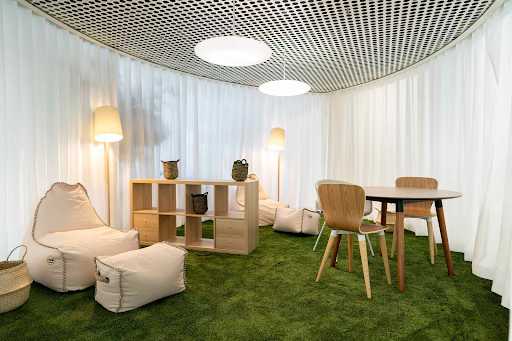
There are some furniture elements that can contribute to creating the perfect wellness space in your office. Consider the following for a wellness space that you might want to create:
Ergonomic furniture is designed to improve posture and reduce strain on the body. This type of furniture is especially important for employees who sit at a desk for extended periods. Ergonomic chairs and desks can be height-adjustable to accommodate the individual needs of employees and help prevent common health issues associated with sitting for long periods.
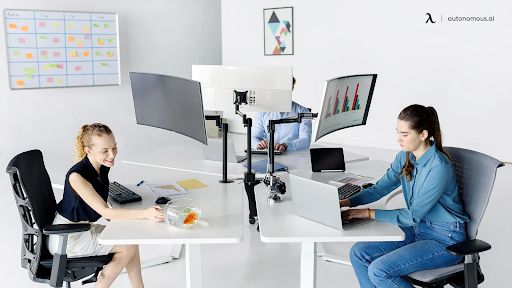
Studies have shown that sitting for long periods is not good for our health. Sitting for long hours can lead to obesity, diabetes, high blood pressure, and other health problems. Sit-stand desks allow employees to alternate between sitting and standing while working, which can help reduce the risk of these health problems. Height adjustable desks such as the Enhance pods are adjustable, allowing employees to switch back and forth between positions as needed throughout the day.
Spending time in nature has been shown to improve our mental health. Outdoor office furniture, such as picnic tables or benches, provides a way for employees to spend time outside during their breaks. A nature break can provide much needed Vitamin D, help reduce stress, boost creative thinking, and promote a better mood.

Comfortable soft seating allows wellness rooms to be more homely and welcoming, for a place to relax and refocus. This type of seating also offers pops of colour to brighten up or calm a room down.
Collaborative spaces are an excellent way to promote teamwork and communication among employees. These spaces can be outfitted with comfortable, modular furniture that is flexible and easy to rearrange. Collaborative spaces can also include whiteboards, display screens, and other technology that supports group meetings and presentations.
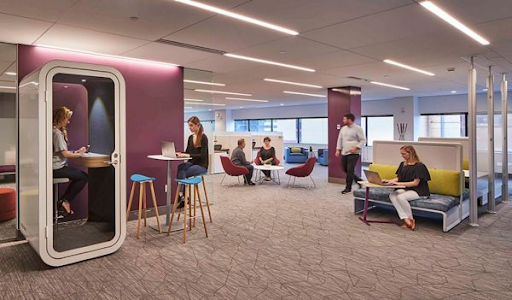
Lighter furniture materials, such as mesh and aluminium, are becoming increasingly popular in office furniture design. These materials are not only lightweight but also easier to clean and maintain. They are also more environmentally friendly as they use fewer resources to produce and transport.
There are many ways that employers can improve workplace wellness, and incorporating wellness trends into office furniture is a great place to start. With the right spaces, you can create a work environment that promotes physical activity, healthy eating, and mental health management. Not only will this improve employee well-being and productivity, but it will also benefit your business by reducing healthcare costs and employee turnover. So, if you want to create a healthier and happier workplace, start by making simple changes to your office furniture. Talk to our team today about how simple furniture changes can make a difference to your team’s wellbeing.
If you need help to spruce up your office furniture, see our range and get in touch with our team for advice.